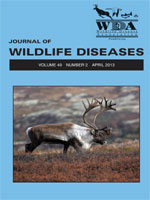The emerging wildlife disease white-nose syndrome is causing widespread mortality in hibernating North American bats. White-nose syndrome occurs when the fungus Geomyces destructans infects the living skin of bats during hibernation, but links between infection and mortality are underexplored. We analyzed blood from hibernating bats and compared blood electrolyte levels to wing damage caused by the fungus. Sodium and chloride tended to decrease as wing damage increased in severity. Depletion of these electrolytes suggests that infected bats may become hypotonically dehydrated during winter. Although bats regularly arouse from hibernation to drink during winter, water available in hibernacula may not contain sufficient electrolytes to offset winter losses caused by disease. Damage to bat wings from G. destructans may cause life-threatening electrolyte imbalances.
How to translate text using browser tools
1 April 2013
Electrolyte Depletion in White-nose Syndrome Bats
Paul M. Cryan,
Carol Uphoff Meteyer,
David S. Blehert,
Jeffrey M. Lorch,
DeeAnn M. Reeder,
Gregory G. Turner,
Julie Webb,
Melissa Behr,
Michelle Verant,
Robin E. Russell,
Kevin T. Castle
ACCESS THE FULL ARTICLE

Journal of Wildlife Diseases
Vol. 49 • No. 2
April 2013
Vol. 49 • No. 2
April 2013
bats
Dehydration
electrolytes
Geomyces destructans
white-nose syndrome




